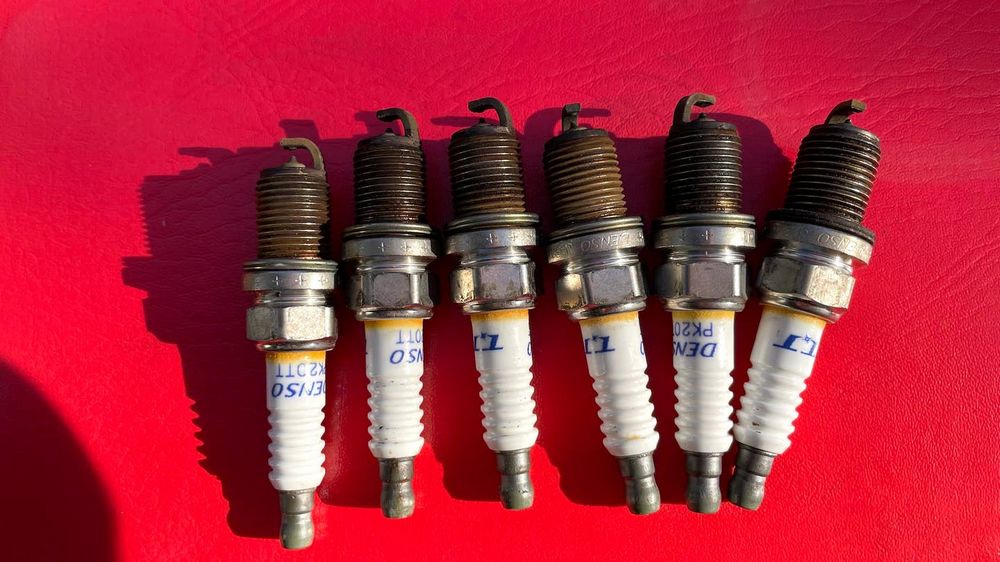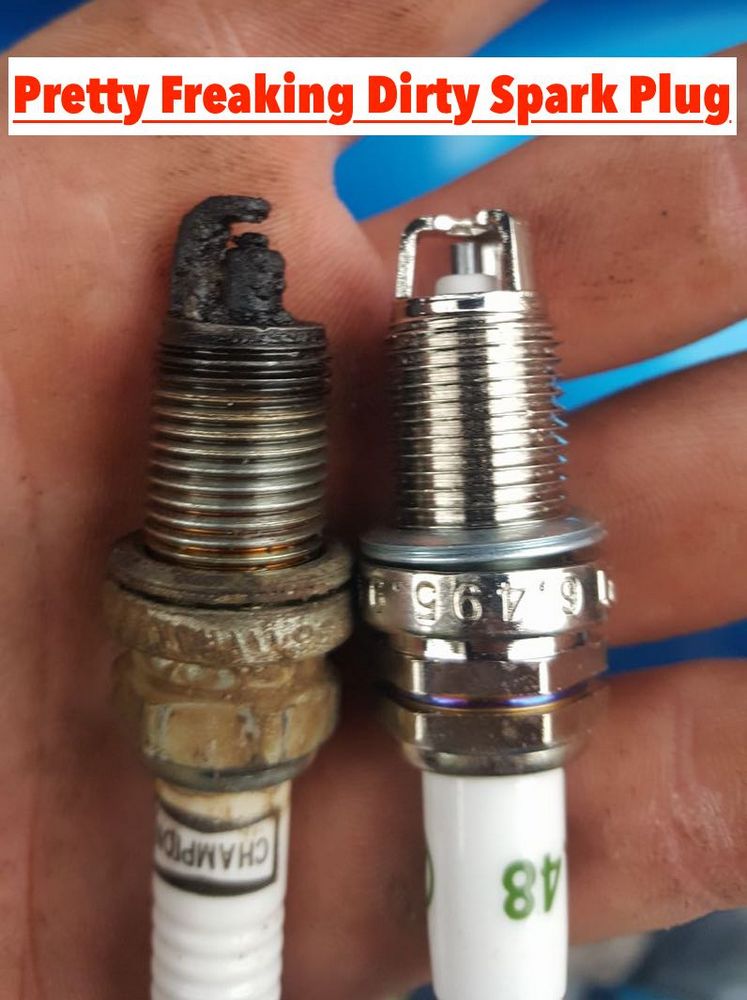5 Signs of Bad Spark Plugs

Spark plugs are an integral part of a vehicle’s ignition system, providing the necessary spark to ignite the air-fuel mixture in the engine. Over time, spark plugs can wear out or become faulty, leading to a number of performance issues. It’s important for car owners to be able to identify the signs of bad spark plugs and take appropriate action to replace them.
One of the most common signs of bad spark plugs is a rough and inconsistent engine idle. When spark plugs are worn out or not functioning properly, the engine may struggle to maintain a steady idle, causing it to shake or vibrate. This can lead to a rough and uncomfortable driving experience.
Another sign of bad spark plugs is a decrease in fuel efficiency. Faulty spark plugs can cause incomplete combustion, resulting in wasted fuel and reduced mileage. If you notice that you’re visiting the gas station more frequently than usual, it could be a sign that your spark plugs need to be replaced.
Difficulty starting the engine is also a common sign of bad spark plugs. If your vehicle struggles to start or requires multiple attempts before it turns over, it may be due to worn out or faulty spark plugs. Ignoring this issue can lead to more serious problems with the ignition system.
In addition, misfiring and engine hesitation are signs that your spark plugs need attention. When spark plugs misfire, the engine can sputter or jerk, and there may be a noticeable loss of power. Engine hesitation can occur when the spark plugs are not firing consistently, leading to a delay in acceleration. Both of these issues can be resolved by replacing the faulty spark plugs.
In conclusion, being able to identify the signs of bad spark plugs is crucial for maintaining the performance and efficiency of your vehicle. By paying attention to rough engine idle, decreased fuel efficiency, difficulty starting the engine, misfiring, and engine hesitation, you can determine if your spark plugs need to be replaced and ensure that your vehicle remains in top shape.
Difficulty in Starting the Engine
One of the common signs of bad spark plugs is difficulty in starting the engine. If your engine is having trouble starting, it could be due to faulty spark plugs. The spark plugs are responsible for igniting the fuel in the combustion chamber, and if they are bad, they may not be able to create a strong enough spark to ignite the fuel properly.
In such cases, you may notice that the engine cranks for a longer time before it starts, or it may struggle to start at all. You may also experience rough idling or stumble when the engine does start. This can happen because the spark plugs are not firing consistently or are not producing enough spark to keep the engine running smoothly.
If you are facing difficulty in starting your engine, it is recommended to check the spark plugs as one of the potential causes. By inspecting the spark plugs, you can determine if they are worn out, covered in deposits, or if the gap between the electrodes is too wide. If any of these signs are present, it is best to replace the spark plugs to ensure optimal engine performance.
Remember, a bad spark plug can not only make it difficult to start your engine but also lead to poor fuel efficiency and engine misfires. Therefore, it is important to regularly inspect and replace your spark plugs to avoid these issues.
Poor Fuel Economy
One of the signs of bad spark plugs is poor fuel economy. If your spark plugs are not in good condition, they may not be able to properly ignite the fuel in your engine’s combustion chamber. This can lead to incomplete combustion and inefficient fuel consumption. As a result, your vehicle may consume more fuel than usual, causing a decrease in fuel efficiency.
If you notice that you are filling up your gas tank more often than usual or if you are not getting the same mileage per gallon, it may be a sign that your spark plugs are not functioning properly. It is important to address this issue as soon as possible to avoid wasting fuel and to improve your vehicle’s overall performance and fuel efficiency. Replacing your bad spark plugs with new ones can help restore optimal fuel economy and save you money in the long run.
In addition to poor fuel economy, other signs of bad spark plugs include difficulty starting your vehicle, engine misfires, rough idle, and a decrease in acceleration and power. If you experience any of these symptoms, it is recommended to inspect and replace your spark plugs if necessary.
Engine Misfires
One of the clear signs of bad spark plugs is engine misfires. When spark plugs are functioning properly, they ignite the air and fuel mixture in the engine’s cylinders, providing the necessary combustion for the engine to work efficiently. However, if the spark plugs are worn out or faulty, they may not be able to generate enough spark or ignite the mixture properly. This can result in misfires, where the engine fails to run smoothly or may even stall.
Engine misfires can manifest as rough idling, noticeable vibrations, or a lack of power when accelerating. It can also cause the Check Engine light to illuminate on the dashboard. If you experience any of these symptoms, it is important to have your spark plugs checked and replaced if necessary.
Regular maintenance and replacement of spark plugs is essential to keep your engine running smoothly. It is recommended to consult your vehicle’s owner’s manual or a professional mechanic for the appropriate intervals for spark plug replacement. By keeping an eye out for the signs of bad spark plugs, you can ensure your engine remains in good working condition.
Rough Idle
A rough idle is one of the signs of bad spark plugs. When the spark plugs are not functioning properly, they can cause the engine to run unevenly at idle. This can result in the engine shaking, vibrating, or even stalling when the vehicle is at a stop.
If you notice that your engine is running rough or feels shaky when idling, it is likely a sign that your spark plugs need to be replaced. Faulty spark plugs can lead to misfires, which can cause the engine to run rough and make the vehicle less reliable.
To fix a rough idle, it is important to replace the bad spark plugs. By installing new spark plugs, you can ensure that the engine is getting the proper spark it needs to run smoothly at idle. Regular maintenance and replacing spark plugs at the recommended intervals can help prevent rough idling and other engine issues.
Lack of Power and Acceleration
One of the signs of bad spark plugs is a lack of power and acceleration in your vehicle. When spark plugs are worn out or faulty, they can’t generate enough spark to ignite the air and fuel mixture in the engine cylinders, resulting in a weak combustion process.
This can cause a decrease in engine power, making it difficult to accelerate your vehicle. You may notice that it takes longer for your car to pick up speed, especially when trying to pass another vehicle or merge onto a highway.
If you’re experiencing a lack of power and acceleration, it’s important to have your spark plugs checked and replaced if necessary. Ignoring this issue can lead to further damage to your engine and decreased fuel efficiency.
Summary:
A lack of power and acceleration is one of the signs of bad spark plugs. Worn out or faulty spark plugs can’t generate enough spark to ignite the air and fuel mixture in the engine cylinders, resulting in a weak combustion process. This can cause a decrease in engine power and make it difficult to accelerate your vehicle.
How to Identify Bad Spark Plugs
Spark plugs are an important component of your vehicle’s ignition system, and if they are not functioning properly, it can lead to a variety of issues. Here are five signs that your spark plugs may be bad:
| Sign | Description |
| 1. Misfiring Engine | If your engine is misfiring, it could be a sign that one or more of your spark plugs are not igniting the fuel-air mixture correctly. This can result in a rough running engine and decreased performance. |
| 2. Difficulty Starting the Engine | If your engine is having trouble starting, especially in cold weather, it could be due to worn-out spark plugs. Faulty plugs can make it harder for the engine to generate the necessary spark to ignite the fuel. |
| 3. Poor Fuel Economy | Bad spark plugs can lead to inefficient combustion, causing your engine to burn more fuel than necessary. If you notice a sudden decrease in fuel economy, it could be a sign that your spark plugs need to be replaced. |
| 4. Engine Surging or Hesitation | When your spark plugs are faulty, your engine may surge or hesitate during acceleration. This can make your vehicle feel jerky or unresponsive. If you experience these symptoms, it’s a good idea to have your spark plugs checked. |
| 5. Rough Idle | If your engine is idling roughly or experiencing a rough idle, it could be due to worn-out spark plugs. The plugs may not be providing a consistent spark, causing the engine to run poorly at idle. |
If you notice any of these signs, it’s important to have your spark plugs inspected and replaced if necessary. Regular maintenance and timely replacement of spark plugs can help keep your engine running smoothly and efficiently.
Check for Physical Damage
One of the signs of bad spark plugs is physical damage. It’s important to inspect your spark plugs regularly for any signs of damage, as they can directly affect the performance of your engine.
Here are 5 common physical signs that indicate your spark plugs may need replacing:

| 1. | Cracked insulator |
| 2. | Worn or damaged electrode |
| 3. | Black carbon deposits |
| 4. | Oil or coolant fouling |
| 5. | Corrosion on the spark plug threads |
Any of these physical signs can lead to poor ignition, misfires, and decreased fuel efficiency. If you notice any of these signs during your inspection, it’s recommended to replace your spark plugs as soon as possible to avoid further engine damage.
Inspect for Carbon Deposits
One of the signs of bad spark plugs is the presence of carbon deposits. Carbon deposits can accumulate on the spark plugs over time, causing them to become less effective in igniting the fuel-air mixture in the engine.
To inspect for carbon deposits, remove each spark plug one at a time and carefully examine the tip and electrode. Look for any black, sooty, or oily buildup. Carbon deposits can indicate a rich fuel mixture, oil leakage into the combustion chamber, or incomplete combustion.
If you notice significant carbon deposits, it’s recommended to replace the spark plugs. Carbon deposits can affect the performance of the engine, leading to reduced power, rough idle, increased fuel consumption, and difficulty starting the vehicle. Replacing the spark plugs regularly can help maintain optimal engine performance and fuel efficiency.
Check for Oil Fouling
One of the signs of bad spark plugs is oil fouling. Oil fouling occurs when there is an excessive amount of oil on the spark plugs, which can lead to a decrease in engine performance. To check for oil fouling, you can follow these steps:
- Start by removing the spark plug wire from the spark plug. Make sure to wear insulated gloves or use an insulated tool to prevent any chance of shock.
- Using a spark plug socket and ratchet, remove the spark plug from the cylinder head.
- Inspect the spark plug for any signs of oil fouling. Oil fouling can be identified by the presence of oil deposits on the spark plug electrode or insulator.
- If you notice oil fouling, it is important to identify the root cause. Oil fouling can be caused by several factors, such as worn piston rings, worn valve stem seals, or a malfunctioning PCV (positive crankcase ventilation) system.
- To address oil fouling, you will need to replace the spark plug and address the underlying issue causing the oil fouling. It is recommended to consult a professional mechanic to diagnose and repair the issue.
By checking for oil fouling, you can identify and replace faulty spark plugs, ensuring optimal engine performance and fuel efficiency.
Check for Excessive Wear
One of the signs of bad spark plugs is excessive wear. Over time, the metal electrodes on the spark plugs can wear down. This can be caused by normal usage or other factors such as poor fuel quality or engine problems.
To check for excessive wear on your spark plugs, you’ll need to remove them from your engine. Start by disconnecting the spark plug wires and using a spark plug socket to remove each plug.
Once the spark plugs are removed, examine the electrodes. If the electrodes are rounded or worn down, this is a sign of excessive wear and the spark plugs should be replaced. You can compare the condition of your spark plugs to images or descriptions in the manufacturer’s specifications to determine if they need to be replaced.
Replacing worn spark plugs is important for ensuring proper engine performance. Worn spark plugs can cause misfiring, reduced fuel efficiency, and other engine problems. By regularly checking for excessive wear and replacing worn spark plugs, you can help maintain the overall health and performance of your vehicle.
Signs of Bad Spark Plugs
| 1. Check for Excessive Wear |
| 2. Other signs |
| 3. More signs |
| 4. Additional signs |
| 5. Last sign |
Perform a Cylinder Balance Test
If you suspect that you may have bad spark plugs, one way to confirm this is by performing a cylinder balance test. This test is designed to identify any cylinders that are not firing properly, which could indicate faulty spark plugs.
To perform a cylinder balance test, start by warming up your engine to its normal operating temperature. Then, connect a compression gauge to each spark plug hole, one at a time.
Next, disable the fuel and ignition systems by removing the fuel pump relay or fuse and disconnecting the ignition coil. This will prevent the engine from starting while you conduct the test.
With the compression gauge connected, crank the engine for about 5 seconds. Take note of the compression reading for each cylinder.
If one or more cylinders show significantly lower compression than the others, it could be a sign of a bad spark plug. This is because a faulty spark plug may not be igniting the fuel-air mixture properly, leading to incomplete combustion and reduced compression.
It’s important to note that low compression can also be caused by other issues, such as a blown head gasket or worn piston rings. However, if you have already inspected these components and ruled out any other problems, then it’s likely that the issue lies with the spark plugs.
If the cylinder balance test confirms that you have bad spark plugs, it’s important to replace them as soon as possible. Faulty spark plugs can lead to reduced engine performance, misfires, and increased fuel consumption. Replace the spark plugs with new ones that are compatible with your vehicle’s make and model.
Regularly inspecting and replacing your spark plugs is crucial for maintaining optimal engine performance and fuel efficiency. By staying vigilant and addressing any signs of bad spark plugs promptly, you can avoid more serious engine problems down the road.
How to Replace Faulty Spark Plugs
When you notice the signs of bad spark plugs, it’s important to replace them as soon as possible to avoid further damage to your engine. Here are the steps to replace faulty spark plugs:
- Before you start, make sure the engine is cool and turned off.
- Locate the spark plug wires attached to each spark plug. They are usually connected to a distributor cap or ignition coil.
- Disconnect the spark plug wire from the spark plug by gently pulling it off.
- Use a spark plug socket and ratchet to remove the old spark plug by turning it counterclockwise.
- Carefully inspect the old spark plug for signs of damage, such as worn electrodes or excessive carbon buildup.
- Compare the old spark plug to the new one to ensure they have the same specifications.
- Gently thread the new spark plug into the spark plug hole by hand, being careful not to cross-thread it.
- Use the spark plug socket and ratchet to tighten the new spark plug, turning it clockwise until it is snug.
- Reattach the spark plug wire to the new spark plug, ensuring it is securely connected.
- Repeat these steps for each faulty spark plug.
Remember to refer to your vehicle’s owner’s manual for specific instructions and torque specifications, as they may vary depending on the make and model of your vehicle. Regularly inspecting and replacing faulty spark plugs can help maintain the performance and efficiency of your engine.
Gather the Necessary Tools
In order to identify and replace bad spark plugs, you will need to gather a few essential tools. These tools will help you efficiently inspect and replace any faulty spark plugs. Here are 5 essential tools to have:
1. Spark Plug Socket: This specialized socket is designed to fit over the spark plug, allowing you to remove and install it with ease.
2. Extension Bar: An extension bar is necessary for reaching spark plugs located in hard-to-reach places, such as deep engine wells.
3. Ratchet Wrench: A ratchet wrench is used in conjunction with the spark plug socket to tighten and loosen the spark plugs.
4. Spark Plug Gap Gauge: This small tool is used to measure the gap between the spark plug’s electrode and the spark plug wire terminal. It ensures the proper amount of electrical current can pass through the spark plug.
5. Spark Plug Wire Puller: If your vehicle has spark plug wires, a wire puller is necessary to safely remove the wires from the spark plugs without damaging them.
Having these tools readily available will make the process of identifying and replacing bad spark plugs much easier and more efficient. Remember to always refer to your vehicle’s manual for specific instructions and safety precautions when working with spark plugs.
Locate the Spark Plugs
One of the first steps in identifying and replacing bad spark plugs is to locate them in your vehicle’s engine. Spark plugs are small, metal components that are responsible for igniting the air-fuel mixture in the combustion chamber. They are usually found on top of the engine, threaded into the cylinder head.
To locate the spark plugs, you may need to refer to your vehicle’s manual or consult an online resource specific to your make and model. The number of spark plugs in your engine will vary depending on the number of cylinders it has. For example, a typical four-cylinder engine will have four spark plugs.
Once you have located the spark plugs, you can easily identify them by their appearance. Bad spark plugs may have signs of wear or damage, such as a dirty or oily appearance, corrosion, or a cracked ceramic insulator. Additionally, spark plugs that are functioning properly should have a tan or light gray color on the electrode and insulator.
Keep in mind that it is important to follow proper safety precautions when working with your vehicle’s engine. Always make sure the engine is cool before handling the spark plugs, and use caution to avoid damaging any surrounding components.
In the next step, we will discuss how to remove and replace the faulty spark plugs.
Remove the Old Spark Plugs
One of the 5 signs of bad spark plugs is a decrease in engine performance. If you notice that your vehicle is not running as smoothly as it used to, it could be a sign that your spark plugs are worn out and need to be replaced. To do this, you will first need to remove the old spark plugs.
Start by locating the spark plugs in your engine. They are usually attached to thick rubber wires called ignition wires. You will need to remove these wires to access the spark plugs. Carefully grip the ignition wires at their base and gently pull them off the spark plugs. Be careful not to pull too hard as this can damage the wires.
Once the ignition wires are removed, you can proceed to remove the old spark plugs. Use a spark plug socket and ratchet to unscrew each plug counterclockwise. Turn the ratchet until the spark plug is loose enough to be removed by hand. Carefully lift each spark plug out of the engine, making sure not to drop any debris into the engine’s cylinders.
Inspect the old spark plugs for signs of wear or damage. Look for any fouling, such as black soot or oil deposits, which can indicate an issue with your vehicle’s fuel or oil system. If the spark plugs appear dirty or worn, it is best to replace them with new ones.
After removing the old spark plugs, it is important to properly dispose of them. Spark plugs contain small amounts of precious metals, such as platinum or iridium, and should not be thrown in the trash. Check with your local recycling center for information on how to dispose of them properly.
Now that you have removed the old spark plugs, you can proceed to install the new ones. Refer to your vehicle’s manual or consult a professional mechanic for guidance on the proper installation procedure.
By removing and replacing the old spark plugs, you can improve the performance and fuel efficiency of your vehicle, ensuring a smoother and more reliable ride.
Q&A:
How can I tell if the spark plugs in my car are bad?
You can tell if the spark plugs in your car are bad by looking out for certain signs. Some of the signs include difficulty starting the engine, engine misfire, poor fuel economy, engine surging or hesitation, and a rough idle.
What causes spark plugs to go bad?
There are several factors that can cause spark plugs to go bad. Some of the common causes include normal wear and tear, carbon deposits, overheating, improper gap size, and using the wrong type of spark plugs.
How often should spark plugs be replaced?
The frequency of spark plug replacement depends on several factors, such as the type of spark plugs, the condition of the engine, and the driving conditions. In general, it is recommended to replace spark plugs every 30,000 to 100,000 miles or every 2 to 7 years.
Can bad spark plugs cause damage to the engine?
Yes, bad spark plugs can cause damage to the engine if left untreated. When spark plugs are faulty, the engine may not run efficiently, which can lead to poor fuel combustion, increased emissions, and potential damage to other engine components, such as the catalytic converter or oxygen sensors.
Can I replace the spark plugs on my own?
Yes, you can replace the spark plugs on your own if you have the necessary tools and knowledge. However, it is important to consult your vehicle’s manual or seek professional advice if you are unsure about the process. Replacing spark plugs incorrectly can cause further damage to the engine.
What are some signs of bad spark plugs?
Some signs of bad spark plugs include misfiring engine, difficult starting, rough idling, poor fuel economy, and lack of acceleration.




